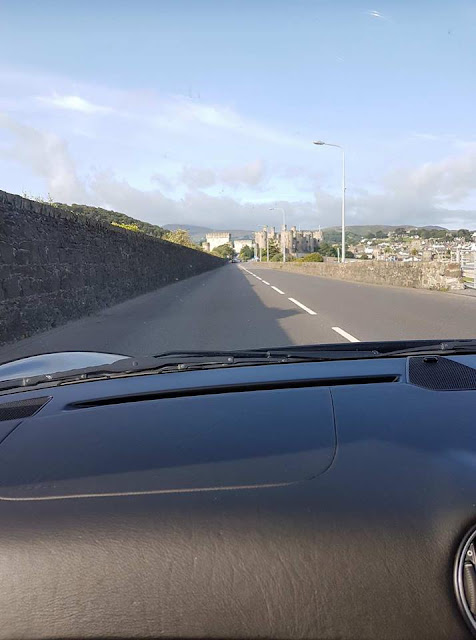Conwy Castle and the bridges
Wales
Up to north: Wales
Conwy Suspension Bridge over the river Conwy. Clwyd
Conwy Castle Wales
Following the outbreak of the English Civil War in 1642, the castle was held by forces loyal to Charles I, holding out until 1646 when it surrendered to the Parliamentary armies. In the aftermath the castle was partially slighted by Parliament to prevent it being used in any further revolt, and was finally completely ruined in 1665 when its remaining iron and lead was stripped and sold off. Conwy Castle became an attractive destination for painters in the late 18th and early 19th centuries. Visitor numbers grew and initial restoration work was carried out in the second half of the 19th century. In the 21st century the ruined castle is managed by Cadw as a tourist attraction.
UNESCO considers Conwy to be one of "the finest examples of late 13th century and early 14th century military architecture in Europe", and it is classed as a World Heritage site. The rectangular castle is built from local and imported stone and occupies a coastal ridge, originally overlooking an important crossing point over the River Conwy. Divided into an Inner and an Outer Ward, it is defended by eight large towers and two barbicans, with a postern gate leading down to the river, allowing the castle to be resupplied from the sea. It retains the earliest surviving stone machicolations in Britain and what historian Jeremy Ashbee has described as the "best preserved suite of medieval private royal chambers in England and Wales". In keeping with other Edwardian castles in North Wales, the architecture of Conwy has close links to that found in the kingdom of Savoy during the same period, an influence probably derived from the Savoy origins of the main architect, James of Saint George.
Conwy Castle (Welsh: Castell Conwy, English: Conway Castle) is a medieval fortification in Conwy, on the north coast of Wales. It was built by Edward I, during his conquest of Wales, between 1283 and 1289. Constructed as part of a wider project to
create the walled town of Conwy, the combined defences cost around £15,000, a huge sum for the period. Over the next few centuries, the castle played an important part in several wars. It withstood the siege of Madog ap Llywelyn in the winter of 1294–95, acted as a temporary haven for Richard II in 1399 and was held for several months by forces loyal to Owain Glyndŵr in 1401.
Conwy Suspension Bridge .
Caernarfon is a royal town, community, and port in Gwynedd, Wales, with a population of 9,615. It lies along the A487 road, on the eastern shore of the Menai Strait, opposite the Isle of Anglesey
Caernarfon castle Wales
Caernarfon Castle (Welsh: Castell Caernarfon), often anglicized as Carnarvon Castle, is a medieval fortress in Caernarfon, Gwynedd, north-west Wales cared for by Cadw, the Welsh Government's historic environment service. There was a motte-and-bailey castle in the town of Caernarfon from the late 11th century until 1283 when King Edward I of England began replacing it with the current stone structure. The Edwardian town and castle acted as the administrative centre of north Wales and as a result the defences were built on a grand scale. There was a deliberate link with Caernarfon's Roman past and the Roman fort of Segontium is nearby.
While the castle was under construction, town walls were built around Caernarfon. The work cost between £20,000 and £25,000 from the start until the end of work in 1330. Despite Caernarfon Castle's external appearance of being mostly complete, the interior buildings no longer survive and many of the building plans were never finished. The town and castle were sacked in 1294 when Madog ap Llywelyn led a rebellion against the English. Caernarfon was recaptured the following year. During the Glyndŵr Rising of 1400–1415, the castle was besieged. When the Tudor dynasty ascended to the English throne in 1485, tensions between the Welsh and English began to diminish and castles were considered less important. As a result, Caernarfon Castle was allowed to fall into a state of disrepair. Despite its dilapidated condition, during the English Civil War Caernarfon Castle was held by Royalists, and was besieged three times by Parliamentarian forces. This was the last time the castle was used in war. Caernarfon Castle was neglected until the 19th century when the state funded repairs. In 1911, Caernarfon Castle was used for the investiture of the Prince of Wales, and again in 1969. It is part of the World Heritage Site "Castles and Town Walls of King Edward in Gwynedd".
Porthmadog, known locally as "Port", and since 1974, rendered into Welsh from its former Anglicised form, Portmadoc, is a small coastal town and community in the Eifionydd area of Gwynedd, in Wales.
Portmadog , Town in Wales
Porth madog railway station serves the town of Porthmadog on the Llŷn Peninsula in Gwynedd, Wales. The station is on the Cambrian Coast Railway with passenger services to Pwllheli, Harlech, Barmouth, Machynlleth, Shrewsbury and Birmingham.
Porthmadog railway station
Porthmadog railway station
Portmadog Railway station in Wales




































No comments:
Post a Comment